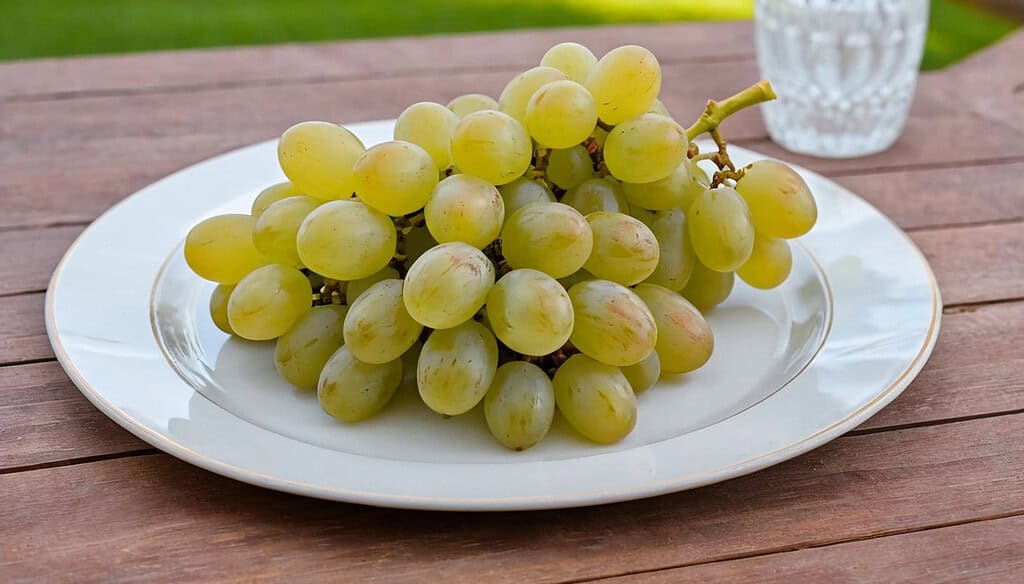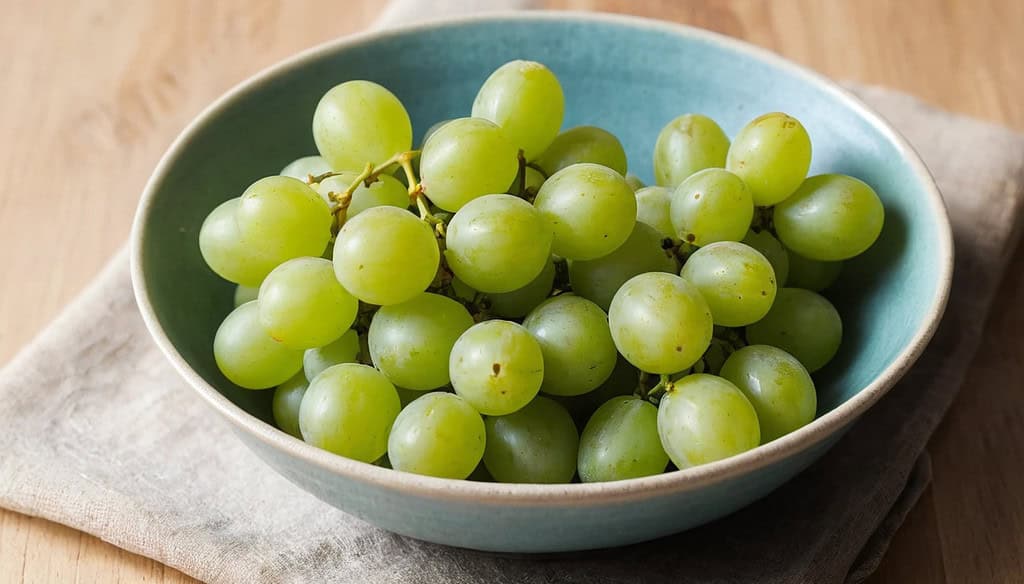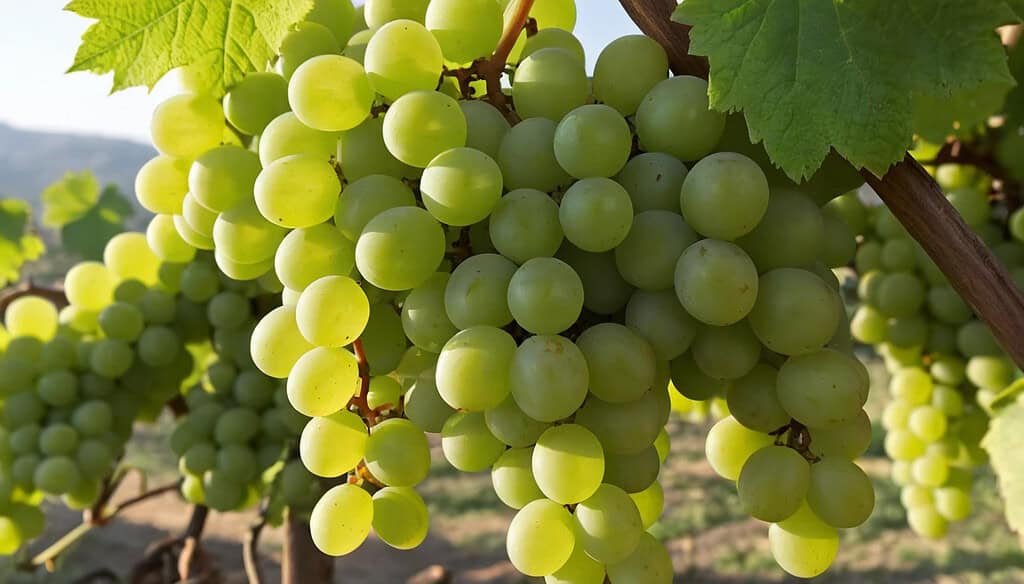Table of Contents
Grapes: A Fruit with a Legacy

Let’s talk about grapes. Scientifically known as Vitis vinifera, these tiny, colorful wonders belong to the Vitaceae family of fruits and have been around for centuries, and their legacy is pretty impressive. From the very first vineyards to today’s bustling grocery stores, these sweet fruits have played a crucial role in cultures worldwide. Whether you’re enjoying a bunch as a snack, sipping on some fine wine, or treating yourself to fresh juice, these amazing fruits are no strangers to everyday life. But their story goes far beyond just filling our stomachs.
Historically, grapes were more than just food; they were a symbol of wealth and abundance. Ancient civilizations, from the Egyptians to the Greeks, saw them as a gift from the gods. They used these fruits for rituals, celebrations, and, of course, wine-making. It’s fascinating to think that the same fruit we casually snack on today has been revered for its medicinal, cultural, and spiritual value for thousands of years.
But grapes’ influence doesn’t stop in the past. Fast forward to the modern era, and these little fruits continue to shine. They’re part of everything from skincare products to health supplements. They’ve gone from an ancient elixir to the superstar of modern wellness trends. And all this time, they’ve been quietly working their way into our kitchens, gardens, and even our beauty routines.
So, the next time you pop a grape into your mouth, remember: you’re not just enjoying a sweet snack. You’re experiencing a piece of history. These amazing little delights have managed to hold onto their charm for centuries, evolving with the times but never losing their cultural significance. It’s pretty remarkable for such a small, simple fruit.
8 Remarkable Ways Grapes Have Shaped History and Modern Era

1. Ancient Elixir: Grapes in Early Wine-Making
Grapes have been around for thousands of years, but their most famous contribution to history? Wine. Ancient civilizations, like the Egyptians and Greeks, were way ahead of their time when it came to discovering the magic of fermenting grapes. Back then, wine wasn’t just a drink—it was an essential part of culture, spirituality, and even medicine.
The Egyptians, for instance, weren’t just drinking wine for fun. They used it in religious ceremonies to honor their gods and connect with the divine. It was part of a sacred ritual, almost like the Devine nectar, that signified luxury and spiritual depth. Meanwhile, the Greeks took things to another level, turning wine into a symbol of social life and celebration. They even had a god—Dionysus—who was the ultimate patron of wine, pleasure, and festivities. Imagine that—a god dedicated to your favorite beverage! Greeks made wine not only for fun but for health, too. They believed it could heal and energize, and often mixed it with herbs for medicinal purposes.
Fast forward to today, and while our modern winemaking techniques are far more advanced, we still honor those ancient traditions. The process of turning grapes into wine has remained surprisingly similar, with fermentation being the key to transforming humble grapes into a flavorful, intoxicating drink. So, the next time you sip on a glass of wine, think about how it connects you to an ancient tradition, one that has been cherished for millennia.
Grapes in wine-making were an elixir for more than just getting a buzz—they were, and still are, a symbol of connection to something larger than ourselves, whether that’s in a celebration or a moment of solitude.
2. Liquid Gold: Grapes in Juices and Beverages
The journey of grapes from ancient vines to your modern juice glass is nothing short of fascinating. Thousands of years ago, people discovered the art of pressing fruits to extract their liquid gold—grape juice. It wasn’t just about quenching thirst; it was about savoring nature’s sweetness in its purest form. In some cultures, fresh juice was reserved for religious rituals, symbolizing purity and abundance.
Fast forward to today, and juices from this fruit have become a cornerstone of health and wellness. Whether it’s a glass of refreshing purple juice rich in antioxidants or a sparkling non-alcoholic beverage served at celebrations, these juices have evolved to suit every taste and occasion. They’re not just tasty but packed with benefits like boosting immunity, improving heart health, and giving your body a quick dose of natural energy.
Let’s not forget the creative twists these beverages have taken. Smoothies, mocktails, and even kombuchas owe part of their charm to the subtle sweetness of this fruit. From breakfast tables to party spreads, it’s clear this juice is a timeless favorite.
Next time you sip on a glass of grape juice, remember you’re part of a tradition that spans centuries. It’s a drink that has adapted and thrived, much like the resilient vines it comes from.
3. Sweet Medicine: Grapes in Traditional Healing
Before modern medicine came along with its fancy pills and treatments, people turned to nature for their healing needs. And guess what was at the top of the list? Grapes. These juicy little fruits weren’t just a tasty snack—they were believed to be a cure-all in many ancient cultures. The Greeks, Romans, and Egyptians all swore by the power of these sweet little fruits, using them in herbal remedies for everything from digestive issues to skin problems.
In ancient times, grapes were seen as a way to balance the body and improve overall well-being. They were used to cleanse the digestive system, detoxify the body, and even improve circulation. Ancient healers made a variety of potions and tonics using these amazing fruits, often mixing them with herbs to enhance their medicinal properties. The rich antioxidants in these little delights—specifically the resveratrol—were believed to fight off illness and keep the body in balance.
Today, we’ve come to recognize many of the health benefits that ancient cultures knew all too well. Grapes are packed with vitamins and antioxidants, like vitamin C and resveratrol, that help protect the body against aging, heart disease, and even cancer. Modern health experts still recommend them as a nutritious snack, and they’re often included in anti-aging skincare products due to their ability to reduce free radicals in the skin.
So, while you might not be using grapes in the form of an ancient remedy, they’re still working their magic in your body today. Whether you’re snacking on them or sipping their sweet juice, you’re not just enjoying something sweet—you’re giving your body a dose of natural goodness that has stood the test of time.
4. Grapes of Wealth: Symbol of Prosperity
Grapes have long been a symbol of abundance and wealth in various cultures. From ancient times to the present day, they have represented prosperity, good fortune, and a life of luxury. Why? Well, it all goes back to the fact that these little fruits were often a rare and treasured commodity. In ancient civilizations like Egypt and Greece, vineyards were a sign of affluence. A flourishing vineyard meant that the land was fertile and prosperous—something that was often associated with wealth.
This symbolism didn’t stop in the ancient world. Fast forward to modern times, and grapes are still considered a luxurious gift. Think about it: these sweet delights are a classic part of celebratory fruit baskets, especially during the holidays or as a token of goodwill. In many cultures, giving grapes symbolizes the wish for prosperity in the coming year. Even the tradition of eating them at midnight on New Year’s Eve in Spain ties into the idea of prosperity, as people eat twelve grapes—one for each chime of the clock—as a way to bring good luck for the year ahead.
Grapes have also been tied to the idea of health and wealth, particularly because of the rich nutrients they contain. In today’s world, giving someone grapes could symbolize not just material wealth but also the wealth of good health. And let’s not forget about the wine industry, which continues to thrive, showing just how much these fruits still hold value in the modern world.
So, while you might not be handing out grapes in the same way the ancient Egyptians did, these little fruits still carry a message of good fortune and prosperity. Whether you’re gifting them or enjoying them for yourself, grapes are a timeless symbol of abundance and wealth that continue to enrich our lives in many ways.
5. Nature’s Snack: Grapes in Culinary Delights
Grapes have always been nature’s candy. From the moment humans discovered these juicy little gems, they became a go-to snack. Imagine ancient farmers plucking clusters straight from the vine, savoring their sweet, refreshing taste under the sun. These sweet little fruits didn’t just satisfy hunger—they were a symbol of nature’s abundance, a treat that required no preparation.
Fast forward to today, and grapes are still one of the most versatile fruits around. Sure, they’re amazing on their own, but they’ve also found their way into countless recipes and cuisines. Think of grape salads, where their sweetness balances tangy vinaigrettes, or grape sauces paired with rich meats to create an explosion of flavors. And who can forget their role in desserts? From pies to sorbets, they add a unique touch of natural sweetness.
Globally, different cultures have given grapes their own twist. In the Mediterranean, they’re wrapped in vine leaves for dolmas. In India, they’re often paired with spices in chutneys. Each dish reflects how they have been embraced and adapted over centuries.
But grapes aren’t just about taste—they’re a snack with benefits. Packed with antioxidants and natural sugars, they’re a healthy alternative to processed snacks. Whether you’re tossing them into your oatmeal, blending them into smoothies, or just popping them in your mouth by the handful, these amazing fruits remain a staple of culinary creativity.
Next time you eat a grape, remember you’re biting into a fruit with a history as rich as its flavor—one that has journeyed through time and across cultures, earning its place on plates worldwide.
6. Home Gardens: Cultivating Grapes for Generations
Grapes have a special charm when grown at home. There’s something deeply satisfying about watching your own vines twist and climb, producing clusters of fruit ready to be picked. This isn’t a new trend— the cultivation of these amazing fruits has been a backyard tradition for centuries. In fact, ancient Romans were known for their villa gardens, where grapevines sprawled as symbols of wealth and agricultural skill.
If you’re thinking of planting grapes, you’re not just growing fruit; you’re joining a legacy of cultivation that has stood the test of time. But where do you start? The key is choosing the right variety. For warm climates, consider sun-loving options like Concord or Thompson Seedless. Cooler regions might favor Niagara or Reliance, which are more cold-resistant.
Grapes thrive in sunny, well-drained spots. A trellis or arbor isn’t just practical—it adds a touch of elegance to your garden. Watching the vines grow, twist, and bloom is as rewarding as harvesting the fruit itself. Regular pruning is crucial for a good yield, but don’t let that scare you. It’s less about perfection and more about learning as you go.
What’s great about grapevines is their longevity. Properly cared for, they can produce fruit for decades, becoming a cherished part of your family’s gardening tradition. Picture kids or grandkids picking grapes straight from the vine, creating memories that last a lifetime.
Home gardening isn’t just about the fruit; it’s about the experience. Grapevines connect us to the earth, to history, and to the simple joy of growing something with your own hands.
7. Preservation Power: Drying Grapes into Raisins
Did you know raisins were probably an accidental discovery? Picture ancient people leaving grapes in the sun, only to find them transformed into sweet, chewy treats. They might not have known the science behind it, but they quickly realized raisins were a game-changer. These dried delights were easy to store, carried well, and packed a punch of natural sweetness—perfect for long journeys or as a winter snack.
Throughout history, raisins have been a staple in many cultures. Ancient Persians used them in stews, while Greeks and Romans included them in desserts and even as currency. Yes, raisins were valuable enough to be traded! Their long shelf life made them essential during times when fresh food was hard to come by.
Today, raisins are everywhere. They sneak into your oatmeal, jazz up your trail mix, and even make their way into savory dishes like couscous. Their versatility is unmatched. Need a quick energy boost? Grab a handful. Want to add texture and sweetness to your baking? Raisins have you covered.
What’s fascinating is how modern preservation methods haven’t strayed far from their roots. Sure, we have industrial drying now, but sun-dried raisins are still a thing, offering that natural, old-school flavor.
Raisins reminds us that food preservation doesn’t have to be complicated. Sometimes, all it takes is a little sunshine and patience to turn fresh produce into something timeless. So, the next time you sprinkle raisins on your salad or bake them into cookies, take a moment to appreciate their journey—from sun-kissed grapes to the pantry staple we all know and love.
8. Modern Marvel: Grapes in Skincare and Beyond
Grapes aren’t just a treat for your taste buds—they’re also a gift for your skin. Believe it or not, the humble grape has become a star ingredient in the world of beauty and wellness. Ancient Egyptians were already on to something when they used grape extracts for their anti-aging properties. Today, that wisdom has been turbocharged by modern science.
Grape seeds, in particular, are a goldmine for skincare. Rich in antioxidants like resveratrol, they help fight free radicals, keeping your skin looking fresh and youthful. Oils extracted from the seeds are now found in everything from moisturizers to serums, offering hydration and a healthy glow. And let’s not forget exfoliation! The crushed seeds make for an excellent natural scrub, leaving your skin silky smooth.
But the wonders of this fruit don’t stop at skincare. Grapes have found their way into wellness trends like detox diets and nutritional supplements. Grape powder, for instance, is packed with nutrients and makes for an easy add-in to smoothies or health bars.
The best part? You don’t need to break the bank to enjoy these benefits. Eating the fruit itself, or even applying a slice to your skin, can give you a dose of its magic. It’s simple, natural, and effective.
These sweet delights have proven they’re not just about flavor—they’re about feeling good, inside and out. From ancient beauty secrets to cutting-edge products, they’ve shown that their versatility knows no bounds.
Grapes: A Fruit Worth Celebrating

When you think of celebrations, what comes to mind? Parties, special occasions, maybe even a glass of bubbly. But have you ever thought about what role grapes play in these moments? From ancient feasts to modern-day toasts, grapes are the unsung heroes of celebration. They’ve been part of human history in ways we might not even realize. Let’s face it—grapes have a legacy that’s worth celebrating!
It’s no surprise that grapes are often linked with celebrations. After all, they were used for wine-making in ancient cultures, and wine has been central to many of humanity’s happiest moments. Birthdays, weddings, holidays—grapes have always been there. They’ve been fermented into wine, pressed into juice, or simply enjoyed as a snack. In ancient times, they were seen as gifts from the gods, often associated with abundance and prosperity. Even today, grapes continue to be a symbol of good fortune and joy, whether they’re in a fruit basket or a wine glass.
But grapes aren’t just reserved for big events. They’re versatile, easy to enjoy, and they’ve made their way into our daily routines in many different forms. Whether you’re throwing a quick snack together or blending up a fresh smoothie, grapes add sweetness and nutrition in a way that other fruits just can’t. Their history of versatility has made them a go-to for everything from health benefits to aesthetic appeal.
And let’s not forget about their modern role. With the rise of health-conscious living, grapes are a favorite choice for those seeking nutritious, yet delicious, options. From antioxidants to vitamins, grapes pack a punch when it comes to boosting overall health. So, the next time you grab a bunch, remember: you’re not just snacking on something sweet. You’re celebrating a fruit that has stood the test of time, in both your health and your heart.
Caution: When Sweet Turns Sour – Why Moderation Matters with Grapes

Grapes are a joy to eat—juicy, refreshing, and oh-so-versatile. But as much as we love these fruits, there’s a little secret that often goes unspoken: too much of a good thing can sometimes be… not so good.
Let’s start with the sugar. While natural sugars are better than processed ones, overindulging in these sugary gems can give your blood sugar levels a bit of a rollercoaster ride. This is especially important for those managing diabetes or watching their carbohydrate intake. A handful is delightful; a whole bag might not be.
And then there’s digestion. Have you ever eaten too many of these fruits in one sitting, only to find yourself feeling a little too “regular”? That’s the fiber doing its thing. While fiber is great in moderation, overloading on it can leave you bloated or uncomfortable.
For some, the skins of these amazing fruits can cause minor allergic reactions—think itchy throat or slight swelling. It’s rare, but worth keeping in mind, especially if you’re trying them for the first time. And let’s not forget about their seeds, which can be a choking hazard for young children or just a nuisance for adults.
Even the natural chemicals in these fruits, like tannins, can upset sensitive stomachs or contribute to headaches in certain individuals. Pair that with potential pesticide residues (if they’re not organic), and you have a solid case for moderation.
The takeaway? These sweet delights are fantastic for your health, but like anything in life, balance is key. Enjoy them as part of a varied diet, savor their flavor, and remember: sometimes, less is more. Your stomach—and your taste buds—will thank you.
Disclaimers: *This article is only for informational purposes.
**Do not make your important decisions solely based on the information provided in this article. Do your own research.
***Consult a doctor or a medical professional in case of a medical emergency.
****We can’t guarantee that the information in this article is 100% correct.
*****Information in this article may vary or get updated in the future.
Read More Science and Space Articles
- 8 Reasons Why Bergamot is the Super fruit You Need
- Blood Orange Adventures: Around the World in 8 Recipes
- 8 Remarkable Ways Kumquat Shines in Culture and Cuisine
- 8 Amazing Lime Tales: Ancient Groves to Modern Kitchens
- 8 Weird Ways Grapefruit Can Interfere with Medications
- Pomelo in Culture: 8 Heartwarming Ritual Traditions
- 8 Culinary Uses of Oranges That I Highly Recommend
- 8 Astounding Ways Lemons Have Helped Elevate My Mood
- 8 Irresistible Ericaceae Fruits (Heath Family) to Savor and Enjoy
- 8 Incredible and Healthy Cucurbitaceae Fruits to Enjoy
- Top 8 Delicious Anacardiaceae Fruits You Must Try
- 8 Incredible Musaceae Fruits You Need to Try Right Now
- 8 Incredible Vitaceae Fruits: Nature’s Tasty Treasures
- 8 Incredible Rosaceae Fruits You Need to Discover
- Discover 8 Fruit Families That Enrich Our Daily Diets
- 8 Amazing Citrus Fruits That Will Brighten Your Day




